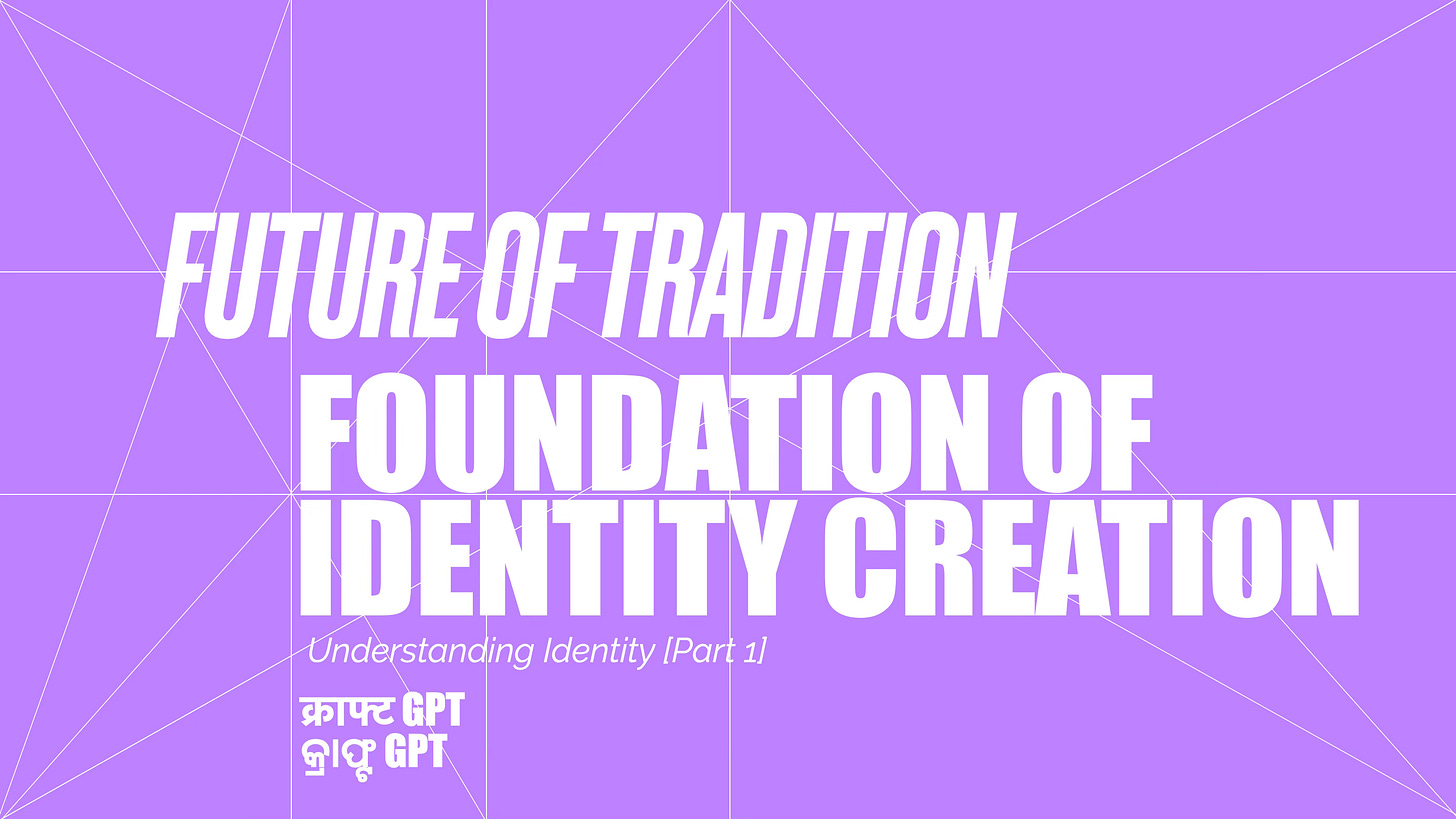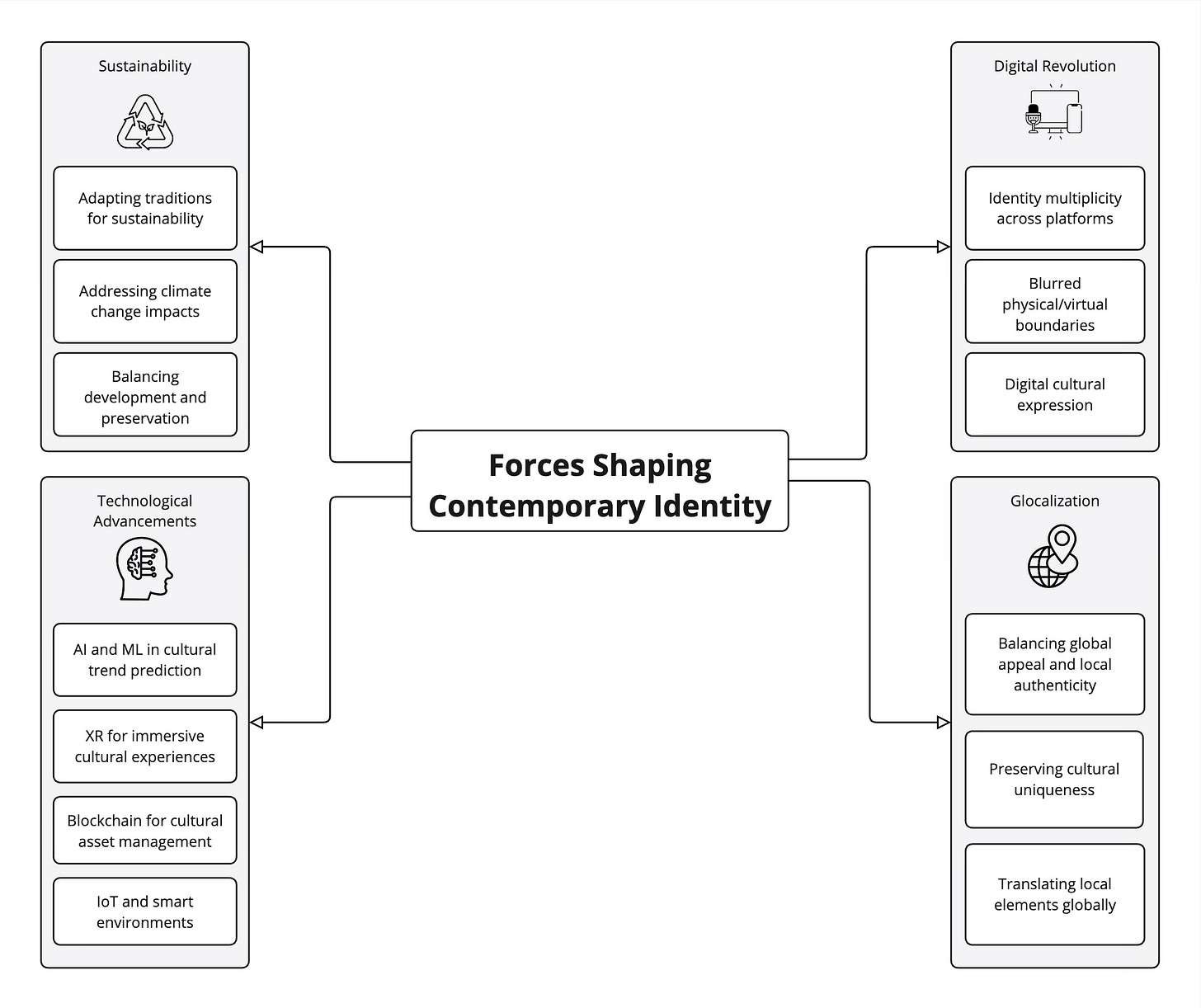Understanding Identity
Advanced Framework for Identity Creation
In the digitally augmented landscape of the 21st century, the concept of identity stands as both anchor and sail. It has become the prism through which we refract our understanding of self, community, and the artifacts of our creation. As our world hurtles towards an ever more interconnected future, identity has emerged as the bedrock upon which we construct meaning in an age of flux.
This three-part series attempts to map the intricate terrain where individual psyche meets collective consciousness, where the tangible embraces the ethereal. We stand at a crossroads of human experience, where the algorithms of artificial intelligence dance with the ancient rhythms of cultural heritage, and where the pixels of our digital avatars carry as much weight as the flesh and blood of our physical forms.
Purpose and Scope
The quad-series aims to provide a comprehensive framework for creating, managing, and evaluating identity across various domains for the 21st century, including urban planning, product design, and branding strategies. By integrating theoretical insights with practical considerations, we seek to enrich the dialogue around identity in contemporary practice, offering valuable insights for professionals and scholars in design, philosophy, and the sciences.
Key Concepts in Identity Creation
Identity as a Multi-Layered Construct
Identity is a complex tapestry woven from values, histories, symbols, and narratives. It encompasses both intrinsic qualities (cultural heritage, historical context, core values) and extrinsic expressions (visual symbols, narratives, spatial configurations). Operating on multiple levels, from personal to communal, tangible to intangible, identity is dynamic and constantly evolving.
Cultural Referencing: Bridging Tradition and Modernity
Cultural referencing involves the deliberate use of historical, artistic, and social symbols to construct narratives that are both meaningful and contextually relevant. It serves to:
Authenticity: By grounding identity in cultural heritage, we create a sense of genuineness and depth.
Continuity: Cultural references provide a link between past and present, offering a sense of historical continuity.
Relevance: By reinterpreting traditional elements, we can maintain cultural significance while addressing contemporary needs.
Adaptability: Cultural referencing allows for the evolution of identity over time, ensuring its ongoing relevance.
This Cultural Referencing Flow Diagram illustrates the dynamic process of cultural referencing in modern identity creation. It begins with traditional cultural elements, which are filtered through a selection process influenced by their relevance to current contexts. These selected elements then undergo an adaptation phase, where they are modified to fit contemporary needs and sensibilities. The adapted elements are then integrated into modern identity expressions, such as visual designs or narratives. Crucially, this integration generates public perception, which feeds back into the cycle, influencing future selections and adaptations of cultural elements. The entire process is continuously shaped by external factors like globalization, social changes, technological advancements, and environmental concerns. This cyclical, adaptive approach ensures that cultural identity remains both rooted in tradition and responsive to modern realities, creating a bridge between past and present in the ongoing evolution of cultural expression.
Narrative Cohesion: Weaving a Coherent Story
Narrative cohesion is the seamless integration of identity elements into a coherent story that resonates with the intended audience. It ensures:
Consistency across all identity elements
Emotional engagement through storytelling
Memorability and lasting impact
Theoretical Frameworks Underpinning Identity Creation
Drawing from the "Culture Stack Elements" diagram, we can reframe our theoretical understanding of identity creation to encompass both tangible and intangible cultural elements:
Holistic Cultural Identity Construction
Key concept: Identity as a dynamic interplay between tangible and intangible cultural elements
This framework synthesizes Stuart Hall's Dynamic Cultural Identity Construction theory (1996) with the Culture Stack elements. It posits that identity is formed through the continuous interaction between physical environments, material culture, and intangible cultural practices.
Semiotic and Symbolic Cultural Expression
Key concept: Identity communication through cultural symbols and practices
Integrating Roland Barthes' Semiotic Theory of Meaning (1957) with the Culture Stack, this framework explores how meaning and identity are constructed and communicated through both tangible symbols and intangible practices.
Collective Identity Through Shared Cultural Elements
Key concept: Building community through shared cultural experiences and environments
Combining Benedict Anderson's Imagined Communities concept (1983) with the Culture Stack, this framework examines how collective identities are formed and maintained through shared engagement with both physical environments and cultural practices.
Place-Based and Object-Oriented Identity Formation
Key concept: Identity rooted in physical spaces and cultural objects
Expanding on Proshansky's Place Identity Theory (1983), this framework includes both geographic and built environments, as well as movable cultural objects as key components of identity formation.
Contemporary Context and Challenges in Identity Creation
Identity creation in the 21st century demands a radical rethinking of our approaches. Four key forces are reshaping the terrain:
1. Digital Revolution and Identity Multiplicity
The digital realm has become a primary stage for identity expression, leading to a fundamental shift in how we construct and communicate our sense of self:
Fragmented identities across multiple platforms: Individuals now curate different personas on various social media platforms, professional networks, and online communities. For example, one might present a polished professional image on LinkedIn, a creative persona on Instagram, and a more personal side on Facebook.
Blurred lines between physical and virtual self-expression: The boundaries between our online and offline identities are increasingly porous. Virtual actions have real-world consequences, and physical experiences are often filtered through digital lenses. This is evident in the rise of influencer culture, where online personas significantly impact offline behavior and vice versa.
A dynamic interplay between traditional and digital cultural elements: Digital technologies are not just preserving traditional cultural elements but transforming them. For instance, traditional art forms are being reimagined through digital media, creating new hybrid cultural expressions that blend the old with the new.
2. Glocalization: Balancing Global and Local
The tension between global homogenization and local preservation necessitates a nuanced "glocal" approach, which seeks to harmonize universal appeal with local authenticity:
Maintaining authenticity while appealing to a global audience: Brands and cultural institutions are challenged to preserve their unique identity while reaching a diverse, global market. This is seen in how international companies adapt their products and marketing to local tastes while maintaining a consistent global brand identity.
Preserving cultural uniqueness amid globalizing influences: Communities are finding innovative ways to celebrate and maintain their distinct traditions in an increasingly interconnected world. This includes efforts to revitalize endangered languages through digital platforms or the adaptation of traditional festivals to include both local and global elements.
Translating local cultural elements for global understanding: There's a growing need to communicate the nuances of local cultures to a global audience without losing their essence. This is evident in the rise of global streaming platforms showcasing diverse, locally-produced content with subtitles and cultural context provided for international viewers.
3. Technological Advancements as Active Participants in Cultural Narratives
Emerging technologies have transcended their role as mere tools, becoming active co-creators of cultural narratives:
AI and Machine Learning are predicting cultural trends and generating new art forms: AI algorithms are now capable of analyzing vast amounts of cultural data to forecast trends and even create original artworks. For example, AI-generated music and visual art are challenging our notions of creativity and authorship.
Extended Reality (XR) technologies are creating immersive cultural experiences: Virtual and Augmented Reality are allowing people to experience cultural heritage sites, historical events, and artistic performances in unprecedented ways. Museums are using these technologies to offer virtual tours and interactive exhibits that transcend physical limitations.
Blockchain and distributed ledger technologies are revolutionizing cultural asset management: These technologies are changing how we authenticate, value, and trade cultural artifacts and digital art. NFTs (Non-Fungible Tokens) have emerged as a new way to establish ownership and provenance for digital creations, impacting the art market and cultural economy.
IoT and smart environments are turning physical spaces into canvases for dynamic cultural expression: Smart cities and connected spaces are becoming responsive to cultural contexts, adapting to the identities and preferences of their inhabitants. This is seen in interactive public art installations that change based on crowd behavior or environmental conditions.
4. Sustainability as a Core Identity Component
Sustainability is becoming integral to cultural identity, presenting both challenges and opportunities for how communities define and express themselves:
Adapting traditions for sustainability without losing their essence: Cultural practices are being reimagined to reduce their environmental impact while preserving their core meaning. This includes modifications to traditional festivals to incorporate eco-friendly materials or the revival of ancient, sustainable agricultural practices.
Addressing climate change impacts on cultural geographic elements: Many cultures are deeply tied to specific landscapes that are under threat from climate change. This is prompting communities to find ways to preserve their cultural identity while adapting to changing environments, such as island nations developing "digital twins" of their lands as sea levels rise.
Balancing development with cultural and environmental preservation: There's a growing recognition of the need to integrate sustainable development with cultural heritage preservation. This is evident in urban planning initiatives that seek to modernize cities while respecting historical architecture and local cultural practices.
Further Research Questions and Hypothesis
To guide future exploration, we pose the following research questions:
How can identity be systematically created and managed across different domains while maintaining coherence, adaptability, and cultural authenticity?
What role do specific cultural stack elements play in enhancing the resonance and recall of identity in an increasingly digitalized and globalized world?
How can identity frameworks be adapted to respond to evolving cultural contexts and technological changes while preserving core cultural essences?
In what ways can digital technologies be leveraged to preserve and promote intangible cultural heritage elements?
How does the interaction between geographic elements and cultural practices shape identity in the context of global mobility and virtual communities?
Hypothesis: An identity framework that integrates diverse cultural stack elements, employs adaptive digital strategies, and maintains a balance between local authenticity and global relevance is more likely to achieve long-term resonance and adaptability across different contexts and technologies.
As we conclude Part 1, we stand at exploring the intersection of tradition and innovation in identity creation. The landscape we've mapped reveals a dynamic ecosystem where culture, technology, and human experience converge and evolve.
This foundation underscores identity creation as a complex process demanding nuanced understanding of both timeless human needs and cutting-edge possibilities. It's a realm where ancient traditions merge with AI, local roots intertwine with global influences, and sustainability becomes central to cultural expression.
Moving forward, I will bridge theory and practice, offering:
Practical frameworks for identity creation - Part 2
Case studies of successful "glocal" identity strategies - Part 3
Metrics for evaluating and evolving identities - Part 4
As we transition from concept to creation, I invite you to join us in reimagining identity. Together, we'll explore crafting identities that aren't just reflections of our present, but beacons guiding us toward a future celebrating values of the 21st century and diversity, authenticity, and harnessing innovation to serve evolving human needs.
In this journey, we are architects of experience, weavers of cultural narratives, and pioneers redefining humanity in the 21st century. The path ahead is challenging yet exhilarating – and the best is yet to come.






